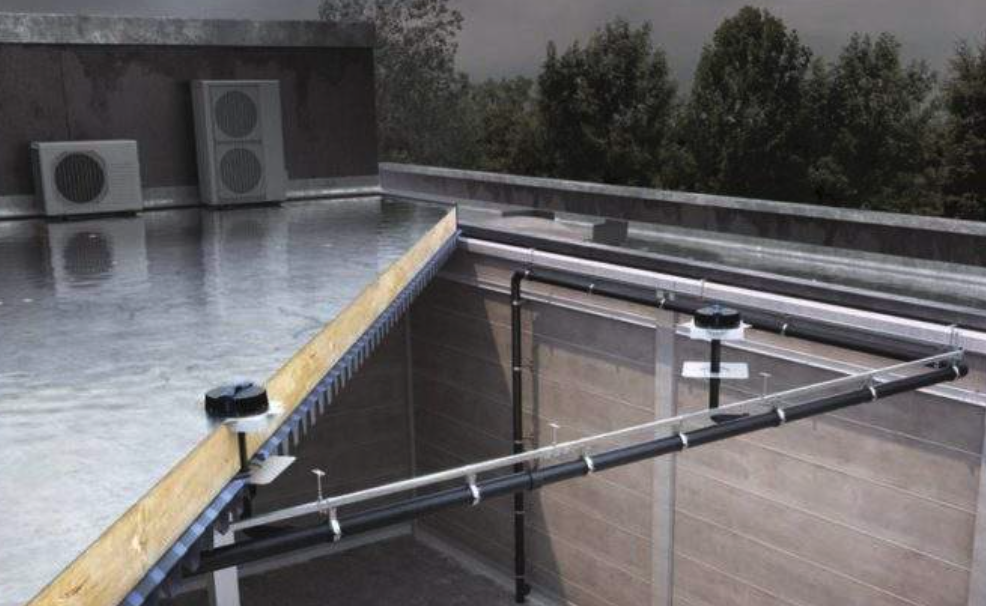What is Siphonic Roof Drainage?
Siphonic roof drainage is a system that uses a powerful hydraulic force to suck water from the roof. The force is created by water accelerating down the full height of the building. This delivers far greater capacity and flow rates than a gravity system.
In a gravity drainage system, pipework carries both air and water. However, the pipework is designed to carry only water in siphonic roof drainage. This means that the system can operate at much higher flow rates, making it ideal for large buildings with extensive roofs.
Siphonic roof drainage is a highly effective and efficient way to manage water on large buildings. If you’re looking for a solution for managing water on your roof, then siphonic roof drainage is an excellent choice.
How does a Siphonic roof drain work?
Siphonic roof drains work by using the natural forces of gravity and atmospheric pressure to move water quickly and efficiently from the roof to the ground. The drain is installed at the low point of the roof, where water will naturally collect. A baffle is installed at the top of the drain to prevent air from entering the piping system.
At full flow, the water is sucked or siphoned from the roof down into the drain at high velocity. This high velocity moves the water through the piping system quickly and efficiently, without allowing air to enter and cause blockages. Siphonic roof drains are an efficient way to quickly remove large volumes of water from a roof and without issue.
What is used to drain water from sloping roofs?
The most common type of drainage system used on sloping roofs is gutters. These handy devices catch rainwater and divert it into a downspout, which carries it away from the foundation. This helps to protect the foundation from water damage and prevents soil erosion around the home. Gutters are available in a variety of materials, including metal, vinyl, and plastic.
They can also be made to match your home’s exterior appearance. So no matter what material your home is built with, there is sure to be a gutter type that fits both its look and purpose. Another important consideration when choosing gutters is their size and placement. To prevent soil erosion around the foundation, it is important that water from rain or snowmelt drains away from the house as quickly as possible, ideally within about 24 hours. Therefore, it is recommended that you install larger gutters near any downspouts located closer to the house than others. Additionally, make sure that all gutters are sloped at least 1/4 inch for every 10 feet in order to ensure proper drainage. By following these tips, you can help keep your home safe from water damage and help maintain its curb appeal for years to come.
What methods are commonly used for roof drainage?
Roof drainage is a critical part of any commercial or industrial building. Without proper drainage, water can pool on the roof and cause serious damage. There are several different methods that can be used for roof drainage, including inner drains, scuppers, gutters, and siphonic roof drains. Each has its own advantages and disadvantages, so it’s important to choose the right method for your particular building.
Inner drains are common in most commercial properties. They consist of a pipe that runs around the perimeter of the roof, carrying water to the downspouts. Inner drains are typically hidden from view, which can be aesthetically pleasing. However, they can be more difficult to install and maintain than other types of drainage.
Scuppers are openings in the side of the wall that allows water to run from the roof to the gutter or downspouts. They are typically located at the corners of the building and can be either round or square. Scuppers are relatively easy to install and maintain, but they can be unsightly.
Gutters are also called conductor pipes. They are installed along the edge of the roof and carry water from the roof to the downspouts. Gutters come in a variety of materials, including plastic, aluminium, and copper. They are typically easy to install and maintain but can be expensive.
Siphonic roof drains use a system of pipes and fittings to create a vacuum that pulls water from the roof and into the drain. They are typically more expensive than other types of drains but can be very effective in areas with heavy rainfall. Siphonic roof drains can be difficult to install and maintain, so it’s important to consult with a professional before choosing this option.
Ultimately, the best method for roof drainage will depend on a number of factors, including the building’s location and climate, as well as your budget and aesthetic preferences. When choosing a method for roof drainage, it’s important to consider all of these factors carefully and work with an experienced professional to ensure that you choose the right option for your building.


No comments yet. Be the first!